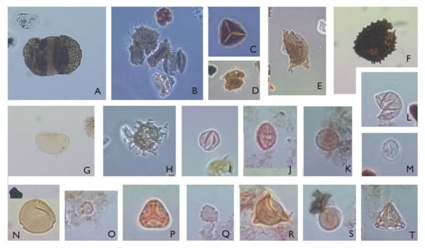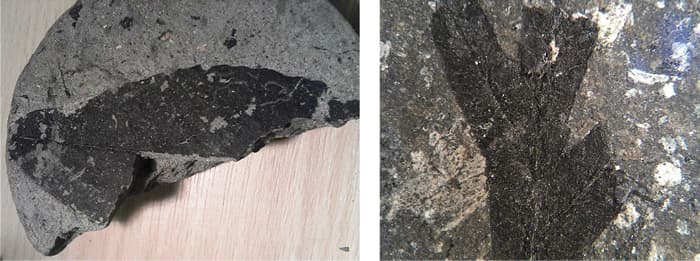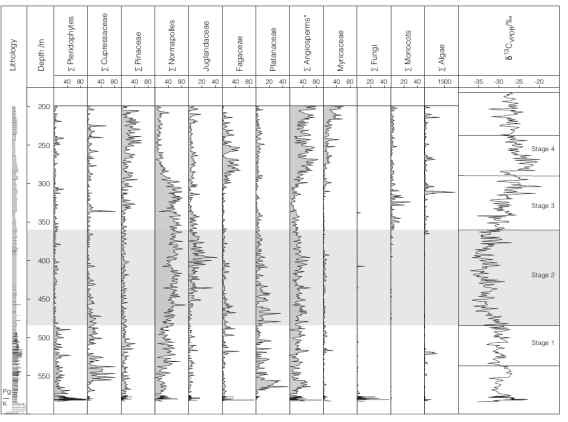Age
Firstly, we have been able to establish the age of the crater more precisely using Ar-Ar dating of the melt rocks, which places it at 65.17ı0.64 Ma (Kelley & Gurov 2002). We have also established, based on palynological evidence that it formed prior to the K-Pg boundary, predating the Chicxulub crater in Mexico. Our work shows that the Boltysh crater formed within as little as 2 - 5 Ky of the Chicxilub impact, synchronous with the K-Pg boundary (Jolley et al. 2010, 2013).
 |
The bottom of the Boltysh core showing the rough lithology, palynological changes and d13C over the bottommost 6 m of the crater - fill. (Jolley et al. 2010). The 'fern spike' characteristic of aftermath of and initial recovery from the K/Pg extinction event is found just above a 0.9 m 'barren zone' devoid of any palynological content. |
An Analogue for Early Life?
Sediments deposited soon after impact can tell us how long the crater lake remained hot. This will be an important result because impact craters may have provided an important habitat for life on early Earth and also possibly on Mars. There were more impacts when the planets were young and warm crater lakes may have been places where early forms of life could survive. A similar study being undertaken in a crater in Africa (Bosumtwi in Ghana) will combine with this work to model crater lakes on early Earth and Mars.
Biotic Recovery
Our third aim is to use pollen, spores and algae preserved in the sediments to uncover information about the process of biotic recovery after a significant meteorite impact event. We can do this by recording the species which tell us about the environment surrounding the lake, and by measuring the variations in organic molecules and carbon isotopes which tell us more about the climate at the time. We know very little about biotic reassembly of a wide sterilised and nutrient poor zone such as the Boltysh ejecta blanket. Those that do exist are based on much smaller volcanogenic landscapes which are not directly analogous because they are richer in nutrients. Studying the Boltysh crater will allow us to produce a detailed model for ecosystem recovery following the impact event, creating a comparator for terrestrial meteorite ejecta fields.
 |
Palynomorphs from the Boltysh crater sediments. All images were taken at approximately x500 magnification. A - F, H: Reworked from Maastrichtian sediments caught up in the ejecta blanket, all showing higher TAI than the insitu flora. G, I - T: Insitu pollen and spores from the Danian crater sediments. |
Climate Record
The core provides an almost continuous record of the climate in central Europe and Asia from the K-Pg boundary throughout the earliest Paleocene (Danian). Climate records for the Danian are scarce and, up till now, have been of low resolution, hence the importance of this data. Palynological data and a high resolution d13 Carbon isotope curve from these sediments go some way towards rectifying this. We were able to use this to discover how climate in continental areas relates to the oceanic signals seen elsewhere, and to compare climatic events in the Danian to other significant episodes throughout earth history. The ubiquitous palynomorphs (above) and occasional plant mesofossils (below) give us an exceptional view of the floras which inhabited the lake, lake margins, and hinterland and how these changed over time.

Plant mesofossils recovered from between thin layers of lacustrine mudstone of the Boltysh core. Left: part of a fern frond of Monheimia spp. Right: An unidentified angiosperm leaf. The entire margin and pinnate venation, suggesting a warm, possibly seasonally dry climate.
Negative δ13Carbon Isotope Excursion (CIE)
Isotope geochemistry of the Boltysh infill shows a pronounced negative excursion (CIE) of up to 5 ‰ in organic carbon (δ13 Corg) over the central part of the core (~ 480 to 360 m). This suggests a period of warming some 100 Ky or so after the K-Pg boundary, followed by climatic recovery (Gilmour et al., 2013). Such episodes, known as 'hyperthermals' record major short-term perturbation in the earth's climate, usually caused by orbital forcing such as changes in the earth's obliquity (axial tilt) or precession (axial wobble), which affect the gaseous content of the atmosphere through large scale volcanism for example.
We see notable changes in palynofloras as a result of this. In the bottommost 90 m or so of the core (following the K-Pg), the dominant palynofloras are ferns, cupressaceous gymnosperms and platanaceous angiosperms, suggesting a warm temperate to subtropical swamp-like environment. In the 120 m above this however, within the CIE, there is a decline in both ferns and gymnosperms, and a notable increase in pollen grains of archaic Normapolles angiosperms and juglandaceous pollen of the genus Platycaryapollenites. This suggests that the CIE was dominated by a warm, dry, winter-wet plant ecosystem inhabited by small, scrubby sclerophylls. The lack of any fresh water algae, which had hitherto been abundant, suggests that the lake, at least to some extent, dried up, and much of the vegetation inhabited the crater floor. The recovery from this, to a cooler, wetter climate is evidenced by a major decline in the representation of Normapolles-type pollen, and a marked increase in pinaceous conifer pollen (suggesting greater fluvial input to the basin), as well as a major increase in numbers of fagaceous, myricaceous and betulaceous pollen (Gilmour et al., 2013). The implication being that an extensive moorland community developed around the lake, dominated by a more heavily arborescent vegetation type.

The d13 Corg and palynological record of the Boltysh core. The negative CIE (highlighted) is easily identifiable in the d13C curve, but is also notable in the vegetation dynamics. Transition from a warm temperate to subtropical swamp (stage 1) to a dryer winter-wet ecosystem (stages 2 and 3) to a cooler open canopy forest and moorland community (stage4) is clearly in evidence. (Gilmour et al., 2013).
